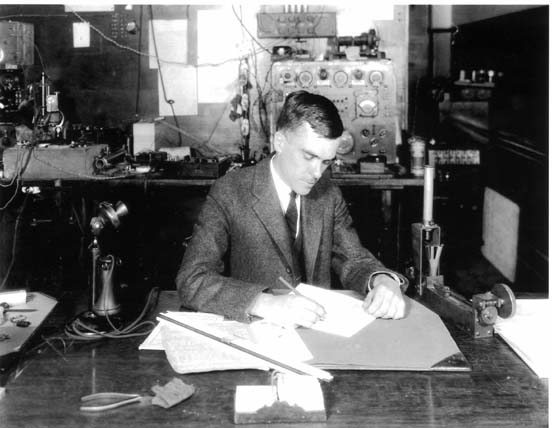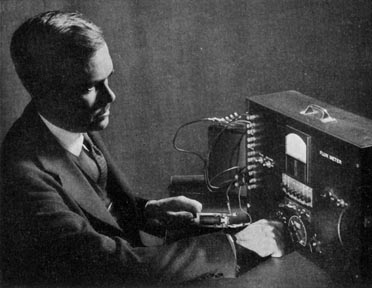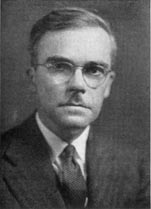Edward Lawry Norton
1898-1983

Bell Labs engineer for whom the Norton equivalent circuit is named
(Photograph taken October 13,1925 and reproduced courtesy of the AT&T
Archives)
Edward Lawry Norton was born in Rockland, Maine on July 28, 1898. He served as a radio operator in the U.S Navy between 1917 and 1919. He attended the University of Maine for one year before and for one year after his wartime service, then transferred to M.I.T. in 1920, receiving his S.B. degree (electrical engineering) in 1922. He started work in 1922 at the Western Electric Corporation in New York City, which eventually became Bell Laboratories in 1925. While working for Western Electric, he earned a M.A. degree in electrical engineering from Columbia University in 1925. He retired in 1961 and died on January 28, 1983 at the King James Nursing Home in Chatham, New Jersey.
Norton became a Fellow of the Acoustical Society of America and of the IRE (latter in 1961). His 1954 biography, reproduced courtesy of the AT&T Archives, says that he had 19 patents; only 18 of which have been found in U.S. PTO records.
|
Date Filed
|
Date Granted
|
Patent No.
|
Title
|
Comments
|
| 11/24/24 | 8/21/28 | 1,681,554 | Wave filter | |
| 11/25/24 | 4/7/31 | 1,799,634 | Wave transmission | |
| 5/12/25 | 4/16/29 | 1,708,950 | Electric wave filter | |
| 7/18/25 | 7/2/29 | 1,719,484 | Carrier transmission system | |
| 3/31/26 | 4/3/28 | 1,664,755 | Electrical network | |
| 9/23/26 | 9/13/27 | 1,642,506 | Wave transmission system | |
| 10/30/26 | 10/29/29 | 1,733,554 | Magnetic device | |
| 5/14/27 | 2/17/31 | 1,792,497 | Vibration clamping device | Joint with A.C. Keller |
| 4/16/29 | 1/13/31 | 1,788,538 | Filtering circuits | |
| 5/31/29 | 2/17/31 | 1,792,655 | Sound reproducer | |
| 7/29/32 | 4/17/34 | 1,954,943 | Wave transmission network | |
| 5/19/34 | 11/5/35 | 2,019,624 | Attenuation equalizer | |
| 8/16/34 | 4/6/37 | 2,076,248 | Wave filter | |
| 9/30/36 | 5/3/38 | 2,115,826 | Impedance transformer | |
| 5/12/37 | 8/16/38 | 2,126,915 | Wave transmission network | |
| 10/18/38 | 5/21/40 | 2,201,296 | Telephone system | Joint with A.A. Lundstrom |
| 9/17/41 | 7/20/43 | 2,324,797 | Differentiating amplifier | |
| 7/7/47 | 2/15/55 | 2,702,186 | Accelerometer | Joint with G.A. Head |
Patents sorted in order of filing date
He published three papers during his lifetime, none of which mention the equivalent circuit associated with him.
| Date | Title | Journal |
Volume
|
Pages | Comments |
| April, 1937 | Constant resistance networks with applications to filter groups | Bell System Technical Journal |
16
|
178-193
|
Bio on p. 250 |
| June, 1942 | Magnetic fluxmeter | Bell Laboratories Record |
20
|
245-247
|
Bio on p. 263 |
| April, 1945 | Dynamic measurements on electromagnetic devices | Transactions AIEE |
64
|
151-156
|
His 1942 paper contains two photographs.
 |
 |
Norton wrote 92 technical memoranda
(TMs in Bell Laboratories parlance). Because of Norton's lack of publications,
it appears that Norton preferred working behind the scenes. As described in
the history of Bell Labs, this reticence belied his capabilities.
Norton was something of a legendary figure in network theory work who turned out a prodigious number of designs armed only with a slide rule and his intuition. Many anecdotes survive. On one occasion T.C. Fry called in his network theory group, which included at that time Bode, Darlington and R.L. Dietzold among others, and told them: "You fellows had better not sign up for any graduate courses or other outside work this coming year because you are going to take over the network design that Ed Norton has been doing single-handed." [Taken from p. 210, A History of Engineering and Science in the Bell System: Transmission Technology (1925-1975)]
He applied his deep knowledge of circuit analysis to many fields, and after World War II he worked on Nike missile guidance systems.
On November 11, 1926, he wrote the technical memorandum Design of Finite Networks for Uniform Frequency Characteristic, reproduced courtesy of the AT&T Archives, that contains the following paragraph on page 9.